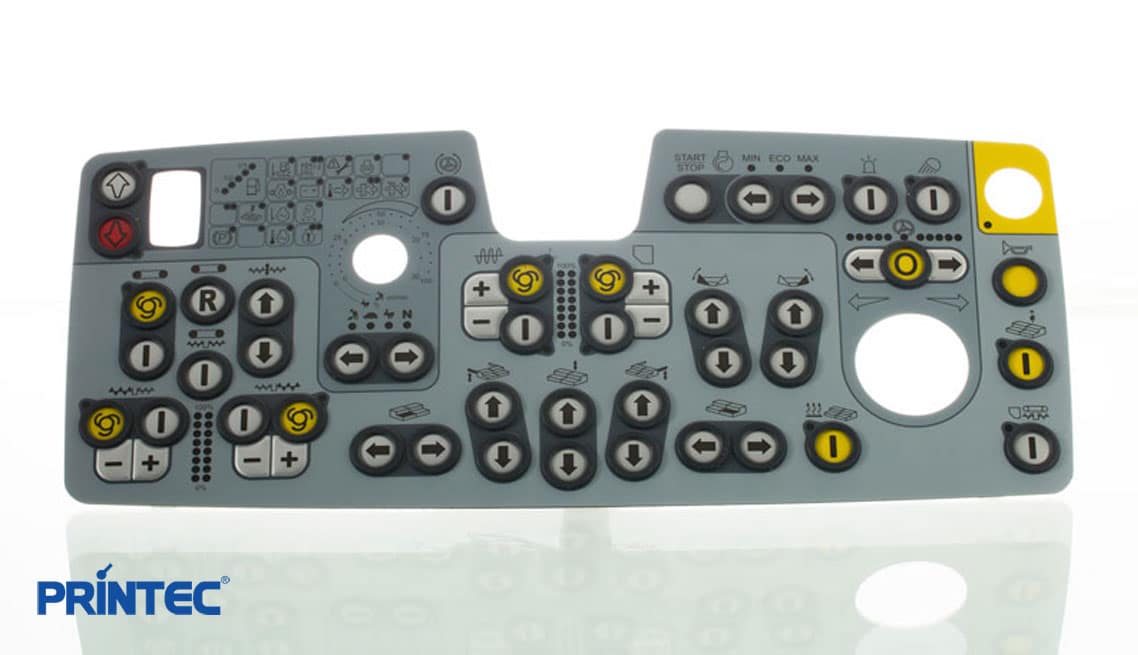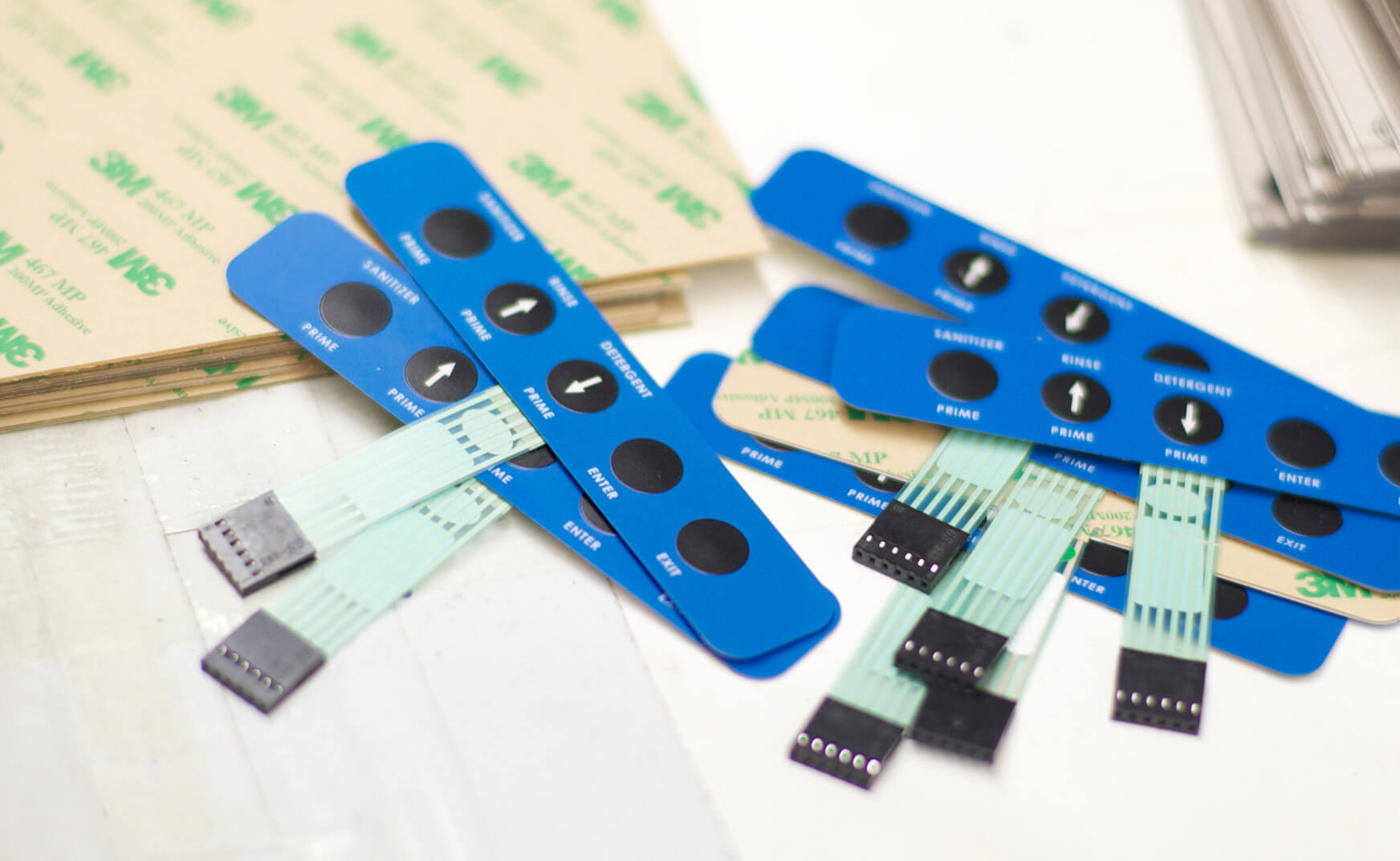Choosing a local membrane switch manufacturer can lower lead times and transportation costs.
What to Look for When Picking a Membrane Layer Switch for Your Project
When you're choosing a membrane switch for your project, several essential variables come right into play. You'll need to think regarding the products, style, and how well it aligns with your brand.
Comprehending Membrane Switch Elements
When you dive into the world of membrane buttons, it's necessary to grasp the vital parts that make them operate. The switch typically contains three main layers: the graphic overlay, the spacer layer, and the circuit layer. The graphic overlay gives the aesthetic user interface, displaying buttons and signs you require for very easy navigating. Under that, the spacer layer assurances there's sufficient range between the circuit and the overlay, allowing the button to activate without constant pressure.
Understanding just how these layers function with each other aids you choose a membrane layer switch that's reliable and fits your job demands. Pay close attention to the density and material of each layer, as these factors influence longevity and capability in different environments.
Product Choice and Its Impact
Selecting the right products for your membrane switch can significantly impact its performance and longevity. The option of substratum, commonly polyester or polycarbonate, influences longevity and versatility. Polyester is much more abrasion-resistant, while polycarbonate uses much better quality and strength.
Following, take into consideration the adhesive. It requires to hold up against environmental aspects like dampness and temperature adjustments. A strong glue guarantees that your membrane switch remains intact in time.
Don't forget the visuals overlay. The printing method utilized, whether silkscreen or digital, influences the switch's appearances and longevity. Premium inks will certainly resist fading and damaging, keeping a specialist appearance.
Finally, think of ecological problems. If your gadget will be subjected to extreme chemicals or severe temperature levels, pick materials made to endure these difficulties. Your selections in materials will inevitably identify the switch's reliability and customer satisfaction.
Design Considerations for Individual Experience
Choosing the ideal materials lays the foundation for a successful membrane switch, but the style additionally plays a substantial function in individual experience. You'll intend to assess exactly how the layout impacts usability (membrane switch manufacturer). Maintain buttons and icons intuitive and well-spaced, making it very easy for users to navigate without complication

Color and contrast are also necessary; guarantee that your style is visually appealing but still useful. High comparison assists individuals easily identify switches, particularly in low-light conditions.
Lastly, assess the total aesthetic. A streamlined and modern-day style can raise user assumption and make your product extra appealing. Balancing capability with an appealing style will certainly lead to a better customer experience and ultimately, an extra successful item.

Environmental Factors and Resilience
When choosing a membrane button, you require to consider exactly how it'll carry out in different atmospheres. Variables like temperature level resistance, dampness and chemical direct exposure, and mechanical wear can greatly impact its longevity. Comprehending these components will certainly aid you select a switch that withstands your certain conditions.
Temperature Resistance Demands
As environmental problems can vary commonly, comprehending temperature resistance is necessary for making certain the longevity of your membrane layer switch. You need to review the temperature range in which your tool will run. High temperatures can trigger products to degrade, bring about failing, while reduced temperatures might make elements brittle and vulnerable to splitting. Make certain to inspect the requirements of the materials utilized in the switch, like the sticky and overlay, as they straight impact performance. It's also important to contemplate prospective temperature level variations and their effects on the button's integrity. By selecting a membrane layer button with sufficient temperature resistance, you'll boost its life expectancy and preserve functionality in tough environments. Select carefully to stay clear of expensive replacements down the line.

Dampness and Chemical Direct Exposure
Dampness and chemical direct exposure can significantly influence the efficiency and longevity of your membrane button, so it's critical to recognize the environment in which it will be used. Constantly seek advice from the supplier's requirements for chemical compatibility to assure your membrane button keeps its performance over time. By focusing on wetness and chemical resistance, you can boost the resilience of your switch in challenging settings.
Mechanical Deterioration
While you might focus on features like visual appeals and functionality in your membrane switch, mechanical wear and tear can substantially influence its efficiency in time. Take into consideration just how often the button will certainly be utilized and the environment it'll remain in. Frequent pressing can cause degradation of materials, triggering issues like tactile responses loss or also change failing. Try to find designs with durable designs, such as those with protective overlays that resist scratches and put on. In addition, look for specifications on cycle life, which indicates the amount of presses the switch can manage prior to revealing signs of wear. Choosing a resilient switch assurances long life and dependability, avoiding pricey replacements and downtime in your project. Constantly element in sturdiness together with aesthetics and functionality for peak efficiency.
Customization Options for Branding
When it pertains to branding your membrane layer switch, personalization alternatives are key. You can choose style aspects and shades that reflect your brand, along with particular logo design positioning and dimension to improve presence. In addition, choosing the ideal materials and textures can elevate the general feel and look, making your product stand apart.
Style Elements and Colors
A large range of design aspects and colors can make your membrane button not simply functional yet likewise visually enticing, improving your brand identity. When selecting colors, consider your brand's combination; they need to reverberate with your target market and evoke the right emotions. You can additionally explore numerous surfaces like matte or shiny to produce different aesthetic effects. Don't neglect about structures; adding a tactile aspect can enhance customer experience and make your button attract attention. Consider integrating customized graphics or patterns that line up with your brand name message. By thoughtfully picking style elements and shades, you not only develop a product that looks fantastic but additionally enhances your find more information branding regularly and effectively.
Logo Positioning and Size
After settling your design aspects and colors, the following action is to concentrate on logo design placement and size. Your logo design is a vital facet of your branding, so you'll want it to attract attention without i thought about this frustrating other layout aspects. Assess where your logo design will certainly be most noticeable and impactful; common placements include the top or facility of the switch.
Don't fail to remember to consider exactly how the logo design aligns with customer communication. This interest to information will enhance both performance and brand name identity in your project.
Material and Texture Options
Selecting the best materials and structures for your membrane switch can considerably boost both its functionality and aesthetic appeal. You'll wish to evaluate choices like polyester or polycarbonate, as they supply toughness and resistance to put on. The structure of the surface likewise plays a vital role; smooth surfaces offer a smooth look, while distinctive surfaces can boost grasp and responsive comments.
Personalizing the materials and appearances permits you to show your brand name identity successfully. For circumstances, you could pick a matte finish to share class or a glossy search for a modern touch - membrane switch manufacturer. Do not fail to remember about shade choices, as dynamic shades can make your switch attract attention, while low-key tones can produce a much more sophisticated look
Cost vs. Top Quality: Discovering the Right Equilibrium
When you're handling the choices for membrane buttons, balancing cost and high quality can feel frustrating. You wish to ensure that you're getting a reliable item without damaging the bank. Begin by identifying your task's specific demands. Are you prioritizing durability or appearances? A lower-cost switch may conserve you money upfront, however if it endangers functionality, you can encounter higher substitute costs later on.
Search for makers that use an excellent mix of affordability and high criteria. Research their track record and customer evaluations to determine dependability. Often, investing a bit a lot more in high quality materials can save you from future frustrations.
Likewise, take into consideration the long-term efficiency discover here and warranty alternatives. A a little more costly button with a strong warranty might verify to be a smarter financial investment. Ultimately, it has to do with finding that sweet area where you satisfy your spending plan while assuring your job's success.
Checking and Quality Control Protocols
While you might locate the perfect membrane layer button style, ensuring its quality through rigorous testing methods is essential for long-lasting success. Begin by confirming that the producer follows industry requirements, such as IPC/WHMA-A -620, to guarantee a trustworthy item. membrane switch manufacturer. You'll wish to inspect for extensive screening methods, including environmental, mechanical, and electric evaluations
Ensure the switches undertake sturdiness testing, mimicing real-world usage to recognize any potential failures. Take notice of the manufacturer's quality control process, which need to consist of routine assessments and audits.

Do not neglect to request for examples and conduct your own examinations to verify compatibility with your task. Lastly, consider how commonly the maker updates their procedures; technology in testing can result in enhanced high quality. By prioritizing these testing and top quality assurance procedures, you'll increase the likelihood of a successful and sturdy membrane button for your application.
Regularly Asked Inquiries
For how long Does a Membrane Layer Change Typically Last?
A membrane button normally lasts anywhere from 1 to 10 million cycles, depending upon use and ecological elements. You'll wish to take into consideration your specific needs to ensure it meets your long life requirements efficiently.
Can Membrane Layer Switches Over Be Repaired if Damaged?
Yes, you can in some cases repair membrane layer buttons if they're damaged, but it typically depends upon the degree of the damage. Small concerns could be fixable, while a lot more considerable damage normally calls for substitute for proper functionality.
What Are the Typical Applications for Membrane Layer Switches?
Membrane switches are frequently utilized in home appliances, medical gadgets, and automotive controls. You'll locate them in customer electronics, commercial tools, and even gaming consoles. Their convenience makes them excellent for numerous customer interfaces and environments.
Are There Certain Qualifications for Membrane Switches?
Yes, there are specific accreditations for membrane switches. Look for UL, CE, and RoHS certifications to assure safety and security and compliance. These certifications indicate the button fulfills sector criteria for high quality and environmental security.
Exactly how Do I Make Certain Appropriate Installment of a Membrane Switch?
To guarantee appropriate setup of a membrane layer switch, clean the surface area extensively, straighten it thoroughly, and apply even stress. Adhere to maker guidelines for glue curing time to make the most of durability and performance.
Conclusion
When picking a membrane switch for your job, maintain these essential factors in mind: prioritize long lasting products, focus on straightforward design, and take into consideration customization for your brand name. By very carefully evaluating these elements, you'll assure your membrane layer switch not only satisfies your job requires however additionally improves customer experience and reflects your brand identification successfully.